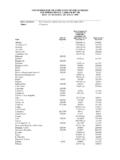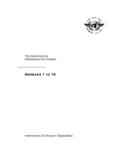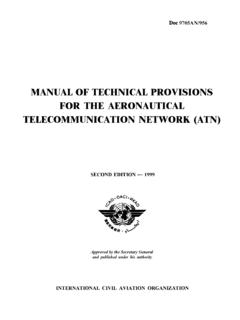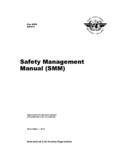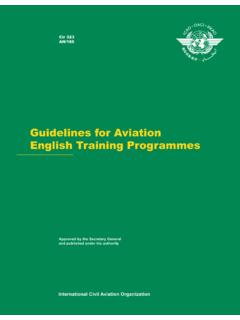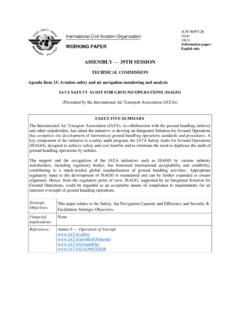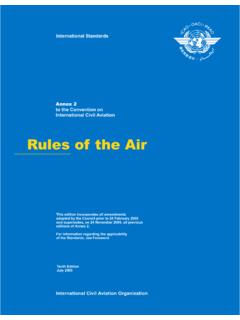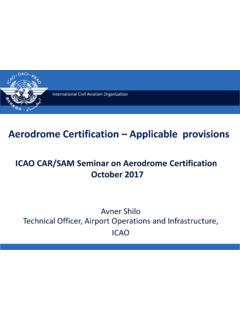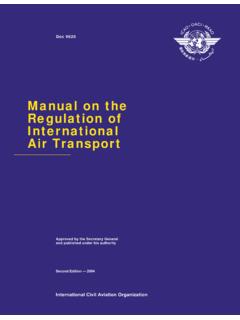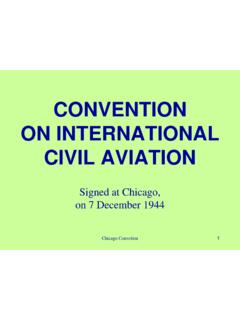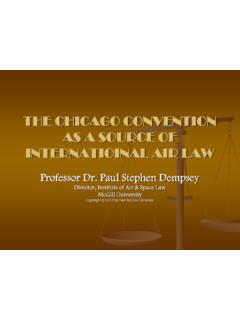Transcription of Annexes 1 to 18 - ICAO
1 The Convention on International Civil AviationAnnexes 1 to 18 International Civil Aviation OrganizationAnnex 1 Personnel LicensingAnnex 2 Rules of the AirAnnex 3 Meteorological Service for International Air NavigationAnnex 4 Aeronautical ChartsAnnex 5 Units of Measurement to be Used in Air and Ground OperationsAnnex 6 Operation of AircraftAnnex 7 aircraft Nationality and registration MarksAnnex 8 Airworthiness of AircraftAnnex 9 FacilitationAnnex 10 Aeronautical TelecommunicationsAnnex 11 Air Traffic ServicesAnnex 12 Search and RescueAnnex 13 aircraft Accident and Incident InvestigationAnnex 14 AerodromesAnnex 15 Aeronautical Information ServicesAnnex 16 Environmental ProtectionAnnex 17 Security: Safeguarding International Civil Aviation Against Acts of UnlawfulInterferenceAnnex 18 The Safe Transport of Dangerous Goods by AirANNEX 1to the Convention on International Civil AviationPersonnel LicensingAs long as air travel cannot do without pilots and other air and ground personnel, their competence, skills and trainingwill remain the essential guarantee for efficient and safe operations.
2 Adequate personnel training and licensing alsoinstill confidence between States, leading to international recognition and acceptance of personnel qualifications andlicences and greater trust in aviation on the part of the and Recommended Practices for the licensing of flight crew members (pilots, flight engineers and flightnavigators), air traffic controllers, aeronautical station operators, maintenance technicians and flight dispatchers , areprovided by Annex 1 to the Convention on International Civil Aviation. Related training manuals provide guidance toStates for the scope and depth of training curricula which will ensure that the confidence in safe air navigation, asintended by the Convention and Annex 1, is maintained. These training manuals also provide guidance for the trainingof other aviation personnel such as aerodrome emergency crews, flight operations officers, radio operators andindividuals involved in other related 's aircraft operations are so diverse and complex that protection must be provided against the possibility, howeverremote, of total system breakdown due to either human error or failure of a system component.
3 The human being is the vital link in the chain of aircraft operations but is also by nature the most flexible and training is necessary so as to minimize human error and provide able, skilful, proficient and competent 1 and ICAO training manuals describe the skills necessary to build proficiency at various jobs, therebycontributing to occupational competency. The medical standards of the Annex, in requiring periodic healthexaminations, serve as an early warning for possible incapacitating medical conditions and contribute to the generalhealth of flight crews and Human Factors programme addresses known human capabilities and limitations, providing States with basicinformation on this vital subject as well as the material necessary to design proper training programmes.
4 ICAO'sobjective is to improve safety in aviation by making States more aware of, and responsive to, the importance of humanfactors in civil aviation operations. Licensing is the act of authorizing defined activities which should otherwise be prohibited due to the potentially seriousresults of such activities being performed improperly. An applicant for a licence must meet certain stated requirementsproportional to the complexities of the task to be performed. The licensing examination serves as a regular test ofphysical fitness and performance ensuring independent control. As such, training and licensing together are critical forthe achievement of overall of ICAO s main tasks in the field of personnel licensing is to foster the resolution of differences in licensingrequirements and to ensure that international licensing standards are kept in line with current practices and probablefuture developments.
5 This is ever more crucial as the flight crew will be exposed to increasing traffic density andairspace congestion, highly complicated terminal area patterns and more sophisticated equipment. To accomplish thistask, Annex I is regularly amended to reflect the rapidly changing 2to the Convention on International Civil AviationRules of the AirAir travel must be safe and efficient; this requires, among other things, a set of internationally agreed rules of the rules developed by ICAO - which consist of general rules, visual flight rules and instrument flight rules containedin Annex 2 - apply without exception over the high seas, and over national territories to the extent that they do notconflict with the rules of the State being overflown. The pilot-in-command of an aircraft is responsible for compliancewith the rules of the aircraft must be flown in accordance with the general rules and either the visual flight rules (VFR) or the instrumentflight rules (IFR).
6 Flight in accordance with visual flight rules is permitted if a flight crew is able to remain clear ofclouds by a distance of at least 1 500 m horizontally and at least 300 m (1 000 ft) vertically and to maintain a forwardvisibility of at least 8 km. For flights in some portions of the airspace and at low altitudes, and for helicopters, therequirements are less stringent. An aircraft cannot be flown under VFR at night or above 6 100 m (20 000 ft) exceptby special permission. Balloons are classified as aircraft , but unmanned free balloons can be flown only under specifiedconditions detailed in the flight rules must be complied with in weather conditions other than those mentioned above. A State may alsorequire that they be applied in designated airspaces regardless of weather conditions, or a pilot may choose to applythem even if the weather is airliners fly under IFR at all times.
7 Depending upon the type of airspace, these aircraft are provided with air trafficcontrol service, air traffic advisory service or flight information service regardless of weather conditions. To fly underIFR, an aircraft must be equipped with suitable instruments and navigation equipment appropriate to the route to beflown. When operating under air traffic control the aircraft must maintain precisely the route and altitude that have beenassigned to it and keep air traffic control informed about its flight plan must be filed with air traffic services units for all flights that will cross international borders, and for mostother flights that are engaged in commercial operations. The flight plan provides information on the aircraft 's identityand equipment, the point and time of departure, the route and altitude to be flown, the destination and estimated timeof arrival, and the alternate airport to be used should landing at destination be impossible.
8 The flight plan must alsospecify whether the flight will be carried out under visual or instrument flight of the type of flight plan, the pilots are responsible for avoiding collisions when in visual flight conditions,in accordance with the principle of see-and-avoid. However, flights operating under IFR are either kept separated byair traffic control units or provided with collision hazard information. Right-of-way rules in the air are similar to those on the surface, but, as aircraft operate in three dimensions, someadditional rules are required. When two aircraft are converging at approximately the same level, the aircraft on the righthas the right of way except that aeroplanes must give way to airships, gliders and balloons, and to aircraft which aretowing objects. An aircraft which is being overtaken has the right of way and the overtaking aircraft must remain clearby altering heading to the right.
9 When two aircraft are approaching each other head on they must both alter heading tothe right. As interceptions of civil aircraft are, in all cases, potentially hazardous, the Council of ICAO has formulated specialrecommendations in Annex 2 which States are urged to implement through appropriate regulatory and administrativeaction. These special recommendations are contained in Attachment A to the AnnexAll these rules, when complied with by all concerned, help make for safe and efficient flight. ANNEX 3to the Convention on International Civil AviationMeteorological Service for International Air NavigationPilots need to be informed about meteorological conditions along the routes to be flown and at their object of the meteorological service outlined in Annex 3 is to contribute to the safety, efficiency and regularity ofair navigation.
10 This is achieved by providing necessary meteorological information to operators, flight crew members,air traffic services units, search and rescue units, airport management and others concerned with aviation. Close liaisonis essential between those supplying meteorological information and those using international aerodromes the meteorological information is normally supplied to aeronautical users by ameteorological office. Suitable telecommunications facilities are made available by States to permit those aerodromemeteorological offices to supply information to air traffic services and search and rescue services. Telecommunicationsbetween the meteorological office and control towers or approach control offices should be such that the required pointsmay normally be contacted within 15 reports and forecasts are required by aeronautical users to carry out their functions.
